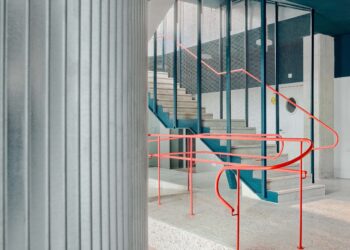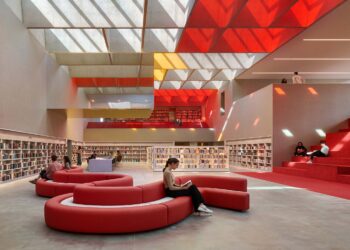“Plug-and-Play Urbanism” informs a pedestrian bridge in Fort Worth
주변 환경에서 영향을 받은 부드러운 곡선형 친환경 목재 보행교

Drift, a timber-and-steel pedestrian bridge by designer Volkan Alkanoglu, has been completed in Fort Worth, Texas. Fabricated offsite, Drift is an innovative example of “plug-and-play urbanism”, a sustainable and affordable design strategy that proposes building infrastructural elements offsite and dropping them into place.
Commissioned by the City of Fort Worth’s Public Art Program, Drift straddles civic design, architecture, and infrastructure. It is a community-driven, site-specific project created to bridge a creek between the parks in two halves of a neighborhood, whose fabrication and installation techniques can be applied to a wide range of communities and uses.
목재 철강 보행교 ‘드리프트’가 2021년 여름, 텍사스 포트워스에 안착했다. 포트워스 공공 예술 프로그램에 의뢰로 만들어진 드리프트는 도시, 건축, 사회 기반 시설을 아우른다. 드리프트는 동네를 둘로 나누는 개울에 다리를 놓는 프로젝트로, 외부에서 제작되어 현장으로 이동하는 지속 가능하고 합리적인 디자인 전략으로 부상한 ‘플러그 앤 플레이 어바니즘’이 적용된 사례다.
공간적, 물질적, 기술적 탐구를 통해 새로운 형태를 추구하는 디자이너 볼칸 알카놀루는 설계에서 세 가지 원칙을 세웠다. 첫째, 지속 가능한 자재를 사용하고 부지의 자연 식생에 영향력을 최소화 하는 것, 둘째, 혁신적인 디자인과 물류 계획으로 시공 비용을 줄이는 것, 셋째, 장소성을 만들고 지역 커뮤니티를 연결하는 것이다.




Alkanoglu implemented three central design principles to the bridge: 1) Use sustainable material and minimize impact on natural habitat on site; 2) Reduce project cost through innovative design and project logistics; 3) Create a sense of place and connect the community. The budget was $375,000—a slim sum for an infrastructure project of this scale.
The design drew inspiration from the Westcreek site and its immediate surroundings. Depending on the season, the creek bed shifts from a container for flowing water to a dry basin filled with driftwood. This process of transformation drove the bridge’s material palette and form. The mid-century modern ranch style homes that fill the neighborhoods on either side of the creek also offered fodder, such as Ray and Charles Eames’ molded plywood innovations, of that era.
The resulting 18m bridge resembles a smooth, curving branch of driftwood arcing over the creek. From other angles it refers loosely to the hull of a ship, with a convex underbelly and a concave hull containing a pathway, benches, and railings. Irregular undulations and curves are engineered for sitting and support. This innovation also draws inspiration from Eames’ splint, “where every function occurs within a single figure,” explains Alkanoglu. Embedding the benches was a means of placemaking, making Drift a space for contemplation, recreation, and communing, rather than just a thruway.



형태는 웨스트크릭 지역과 그 주변 환경에서 영감을 받았다. 두 동네를 가르는 개울 바닥은 계절에 따라 흐르는 물을 품기도 하고, 마른 유역이 되어 유목만 남을때도 있다. 개울을 사이에 둔 두 동네에 즐비한 20세기 중엽 미국 현대식 단층집과 가구 디자이너 부부인 ‘레이 앤 찰스 임스’의 성형 합판 기술에도 영향을 받았다.
18m 길이의 보행교는 개울 위 둥글게 놓여진 유목의 부드러운 곡선형 나뭇가지를 닮아 있다. 다른 각도에서 보면, 볼록한 아랫 부분와 통로, 벤치, 난간이 있는 오목한 부분이 선체를 연상시키기도 한다. 불규칙한 물결 모양의 앉을 수 있는 단일 공간은 자체적으로 지지까지 가능하도록 설계됐다. ‘모든 기능이 하나의 형태 내에서 일어나는’ 레이 앤 찰스 임스의 부목에서 영감을 얻은 것이다. 디자이너는 “다리와 벤치를 결합한 쉼터이자, 단순한 통로가 아닌, 사색, 여가, 교감의 공간이다” 고 설명했다.



Taking a cue from shipbuilding techniques, the designers created a steel armature, and clad it with CNC-cut and flip-milled timber planks—a product of computational design. Each plank is custom cut, then stack-laminated into one large, volumetric, undulating form.
This technique accommodated the bridge’s unique form and met the designer and client’s shared interest in sustainable design strategies. “Our cities urgently need upgrades on all levels, and plug-and-play urbanism is an economically feasible way to produce mid-scale infrastructure offsite and deliver it to its urban context. We can leverage advancements in computational design to be efficient and innovative,” explains the architect.
This process reduces on-site installation time and greatly minimizes disruption to the surrounding community and impact on the creek habitat’s natural vegetation. The craned-in bridge is paired with low impact piers on either side of the bank, and a rip-rap drainage system to create minimum footprints for the bridge foundation.

원래는 교차된 적층 목재만으로 제작할 계획이었다. 예산은 375,000달러(약 4억 5천 만원)로 비슷한 규모의 인프라 프로젝트 치고는 상당히 적은 금액이었다. 예산 제약으로 인해 원래의 계획과는 다른 혁신적인 전략이 필요했다. 조선 기술에서 힌트를 얻어 철강으로 골조를 만들고 컴퓨터 디자인을 이용해 만든 CNC가공 목재 판자로 그 위를 덮었다. 판자들은 모두 맞춤 절단되어 물결 모양의 볼륨으로 이어 붙여졌다.
이 기술은 드리프트만의 특별한 모양을 실현했고, 지속 가능한 디자인 전략을 만족시켰다. 모든 자재는 트럭으로 현장으로 옮겨진 후 크레인을 이용해 설치됐다. 양쪽 제방에도 영향을 덜 미치는 교각을 사용했으며, 사석 기초 배수 시스템으로 다리의 토대도 최소한의 공간을 차지한다. 이러한 제작 및 설치 기술은 현장 설치 시간을 줄여 주변 지역 사회와 개울에 서식하는 식생에 미치는 영향을 최소화하고 지역 사회에도 폭넓게 활용될 수 있다.
Project: Drift / Location: Fort Worth, Texas / Architect: Volkan Alkanoglu / Client: City of Fort Worth, Fort Worth Public Art Program / Public Art Manager: Anne Allen / Design Development and Fabrication: Ignition Arts LLC, Brownsmith Studios / Structural Engineering: CMID Engineers / GeoTechnical Engineering: Alpha Testing / Material Testing: Simpson, Gumpertz & Heger Inc. / Concept Engineering: AKT II / Installation: 2021 / Photograph: ©Jennifer Boomer, ©Peter Molick




































